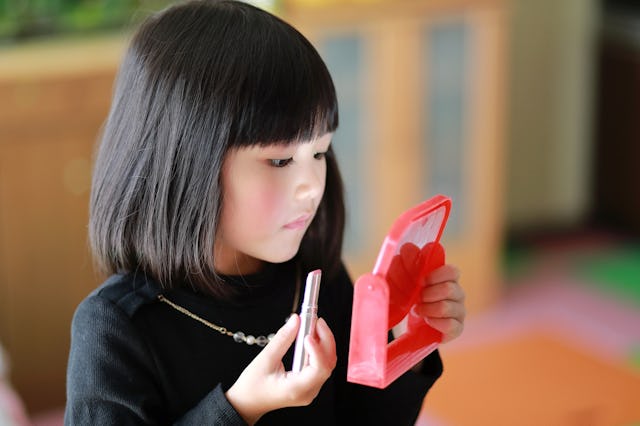Most Kids Are Using Kids Makeup And Body Products That Are Likely Toxic
A new study has found that even makeup marketed to kids can contain lead, asbestos, PFAS, phthalates, and formaldehyde — and most kids play with them regularly.

Playing with makeup can be an iconic part of childhood — and a vital type of pretending that helps kids learn and grow. Many of us can remember slipping into a pair of our mom’s high heels, smearing a line of lipstick across our mouths, and feeling like a real, true grown-up.
But while there should always be a place in childhood for pretending, playing, and dressing up, new research is warning that even when you buy kids special products that are specifically marketed to them, you may be exposing them to toxic chemicals and microplastics that could hurt their health.
In fact, a new study, published in the latest issue of the peer-reviewed journal International Journal of Environmental Research and Public Health, has found that not only do most kids’ makeup and body products contain harmful chemicals, but that most kids regularly use these products and get exposed to these toxins.
Specifically, kids who regularly use products like makeup, face paint, body glitter, and nail polish may be exposed to dangerous levels of lead, asbestos, PFAS, phthalates, and formaldehyde.
The study, which was conducted through 200 surveys at Columbia University’s Mailman School of Public Health, found that 79 percent of parents say their children 12 or younger use makeup and body products (CMBP) marketed to children, like glitter, face paint, and lip gloss — including both boys and girls. Prior studies have found that these products often contain toxic chemicals.
“There is increasing evidence of harmful ingredients often included in adult cosmetics and CMBPs, and children are more biologically susceptible to the effects of toxicants,” study co-first author Eleanor A. Medley told Columbia University.
Specifically, 12 percent of kids under 12 use kids’ makeup or body products daily, about 20 percent use them for eight hours or more at a time, and one out of three parents reported that their kids unintentionally ingested the products in the last year.
The study found that Latino children had higher exposure and reported using the products for play more than other racial groups, with 65 percent reporting regular use.
The study’s authors stressed that this use is concerning because kids are smaller than adults and therefore even low levels of toxic chemicals can have a big impact on their health; not to mention that they are more likely to either intentionally or accidentally ingest products than adults.
“Children are particularly vulnerable to adverse health risks associated with chemicals often found in makeup and body products,” said study senior author Julie Herbstman, director of the Columbia Center for Children’s Environmental Health. “In addition to dermal exposure through the skin, behavioral patterns such as hand-to-mouth activity may increase exposure to products through unintentional ingestion. Additionally, children’s small body size, rapid growth rate, developing tissues and organs, and immature immune systems make them biologically susceptible to the effects of toxicants.”
Lead, asbestos, PFAS, phthalates, and formaldehyde have all been tied to adverse health affects in children, including cancer and neuro-developmental harm.
Still, these products are not tightly federally regulated, although some states, like New York and Washington, are considering new regulations for kids’ toy makeup and personal care items as more data is published.
“It is alarming that industry is being allowed to sell makeup and body products marketed to children that contain extremely toxic chemicals. Findings from this study can help federal agencies better understand how children are using these products and will hopefully spur agencies to act to protect children from toxic chemical exposures,” said Earthjustice Attorney Lakendra Barajas. “Unfortunately, currently little is being done at the federal level to protect children from toxic chemicals in children's makeup and body products.”
This study is coming out just as news of high PFAS level in orange juice, period underwear, and freshwater fish has hit the public in a matter of weeks.
What are the next steps, and what can parents do?
“It is important to uncover how makeup and body products are being used by children to characterize risk and improve safety,” said Kendall E. Kruchten, the co-lead author.
But until that research is done, parents can take action within their own families. The optimal move is to simply not allow your young kids to access these products (or minimize use), and try to find more natural choices for pretend play. You can also reach out to your local representative and let them know that this is a big concern for you and your family.